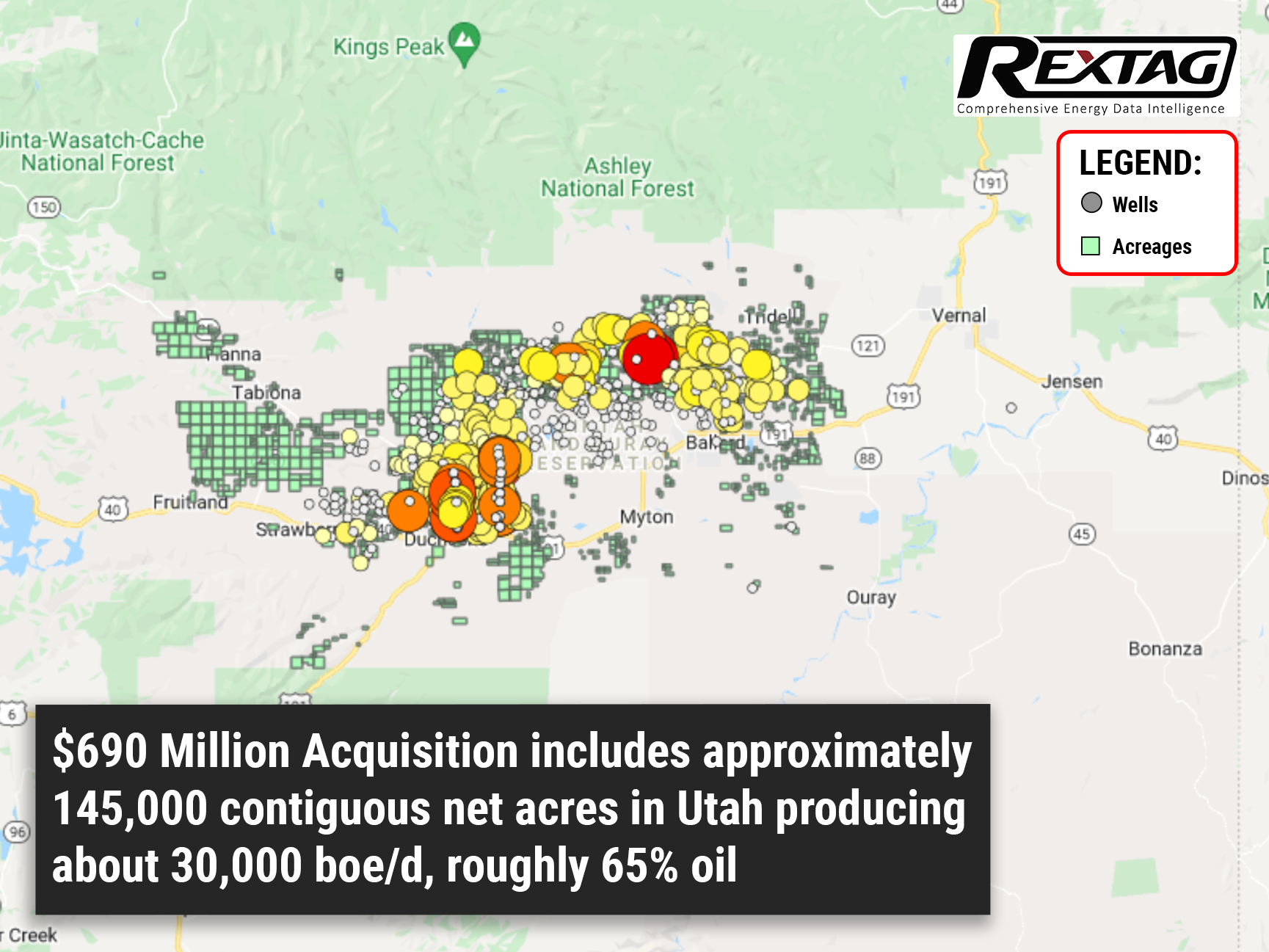Comprehensive Energy Data Intelligence
Information About Energy Companies, Their Assets, Market Deals, Industry Documents and More...
$690 Million Deal Moves Ahead: Crescent Energy to Complete Purchase of EP Energy's Uinta Assets
04/06/2022
On March 30, Crescent Energy closed the acquisition of Uinta Basin assets in Utah that were previously owned by EP Energy for $690 million, a few hundred million dollars below the original price. While a total cash consideration of about $815 million was announced at the time of the transaction's announcement back in February.
At least according to Crescent CEO David Rockecharlie, the accretive deal increases Crescent's Rockies position and adds significant cash flow and a portfolio of high-quality oil-weighted undeveloped sites.
Crescent's acquisition of Uinta indicates its competitive strength and ability to simultaneously deliver shareholder value through accretive acquisitions and to create long-term value for its shareholders through the consolidation of its businesses in today's market.
Upon closing of the Uinta transaction, Crescent's lenders increased the borrowing base under the revolving credit facility to $1.8 billion and the committed amount to $1.3 billion, an increase of $600 million from its previous level.
EP Energy had owned these assets earlier, according to a news release from Crescent Energy on Feb. 16 that was dedicated to the Uinta acquisition. The Uinta comprises about 145,000 contiguous net acres, most of it producing oil (roughly 65%), about 30,000 boe/d.
A year after EP Energy emerged from a bankruptcy process that handed control to its creditors, EnCap Investments agreed to take over EP Energy's assets in the Eagle Ford and Uinta basins for $1.55 billion.
Although U.S. antitrust regulators threatened to hinder EnCap's acquisition of EP Energy, citing the private equity firm's dominant position in the Uinta shale formation as a concern.
According to Reuters, the U.S. government agencies finally approved EnCap's $1.5 billion purchase of EP Energy on the condition that EP Energy's entire Utah oil business be sold. If the assets from Utah hadn't been sold, there would have been just three producers that sell Uinta Basin crude oil to refineries in Salt Lake City, and consumers would have paid more in prices.
Crescent Energy was formed in December when Contango Oil & Gas and KKR went for an all-stock merge. KKR remains the company's partner, but Contango serves as its subsidiary as it manages a portfolio of assets in the Lower 48.
Having completed the Uinta acquisition, Crescent Energy expects to operate two rigs off Uinta for the remainder of the year. In addition to its acquired Uinta assets, Crescent's pro forma year-end 2021 provided reserves totaled 598 million boe, of which 83% was developed, 55% was liquid, and its provided PV-10 was $6.2 billion. Based on the production type curves used in Crescent's third-party reserve reports, a 22% decline rate for its proved developed producing reserves is expected for the first year.
Moreover, on March 30, the company reiterated its previously announced capital investment strategy and production and cost guidance for 2022. Investments in the Eagle Ford and Uinta basins will account for 80%-85% of the $600 million-$700 million capital program for 2022.
Concerning the Uinta acquisition, the Company added additional oil hedges as part of its risk management practices. Together with the expected Uinta volumes, Crescent now has derivative agreements in place covering approximately 60% of its expected total production in 2022.
If you are looking for more information about energy companies, their assets, and energy deals, please, contact our sales office mapping@hartenergy.com, Tel. 619-349-4970 or SCHEDULE A DEMO to learn how Rextag can help you leverage energy data for your business.
To Be or Not To Be: Bakken Assets Could Fetch $5 Billion for Exxon Mobil
![$data['article']['post_image_alt']](https://images2.rextag.com/public/blog/55Blog_Exxon's_Bakken_wells_2022.png)
Exxon Mobil Corp. is weighing prospects of selling its assets in North Dakota’s Bakken, after gauging interest from potential buyers — 5 billion is the issue price, at least according to rumors. The price point came about after the news that the oilgiant is in the final round of hiring bankers to help launch the sale. Yet Exxon Mobil itself stays tight-lipped regarding the situation.
$1B Deal: Williams Buys Out Houston-based Midstream in Haynesville Basin
![$data['article']['post_image_alt']](https://images2.rextag.com/public/blog/52Blog_Williams_Acquires_Assets_from_Trace_in_Haynesville.png)
By purchasing the gathering and processing assets of Trace Midstream, Williams' existing footprint gains expanded capacity in one of the nation's largest growth basins, bringing its Haynesville gathering capacity to over 4 Bcf/d — increasing more than 200% from 1.8 Bcf/d. The deal also includes a long-term commitment from Trace and Quantum to support Williams' Louisiana Energy Gateway project (LEG), which is aimed to deliver responsibly sourced Haynesville’s naturalgas to markets along the Texas and Louisiana GulfCoast
![$data['article']['post_image_alt']](https://images2.rextag.com/public/blog/328_Blog_Why Are Oil Giants Backing Away from Green Energy Exxon Mobil, BP, Shell and more .jpg)
As world leaders gather at the COP29 climate summit, a surprising trend is emerging: some of the biggest oil companies are scaling back their renewable energy efforts. Why? The answer is simple—profits. Fossil fuels deliver higher returns than renewables, reshaping priorities across the energy industry.
![$data['article']['post_image_alt']](https://images2.rextag.com/public/blog/327_Blog_Oil Market Outlook A Year of Growth but Slower Than Before.jpg)
The global oil market is full of potential but also fraught with challenges. Demand and production are climbing to impressive levels, yet prices remain surprisingly low. What’s driving these mixed signals, and what role does the U.S. play?
![$data['article']['post_image_alt']](https://images2.rextag.com/public/blog/326_Blog_USA Estimated Annual Rail CO2 Emissions 2035.jpg)
Shell overturned a landmark court order demanding it cut emissions by nearly half. Is this a victory for Big Oil or just a delay in the climate accountability movement?